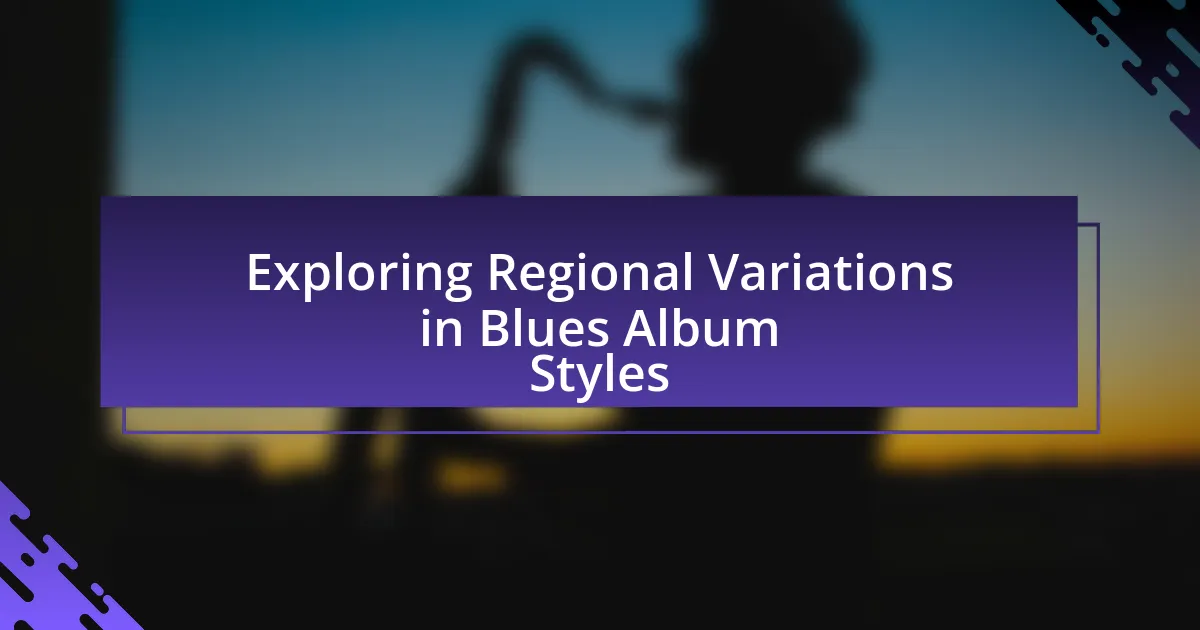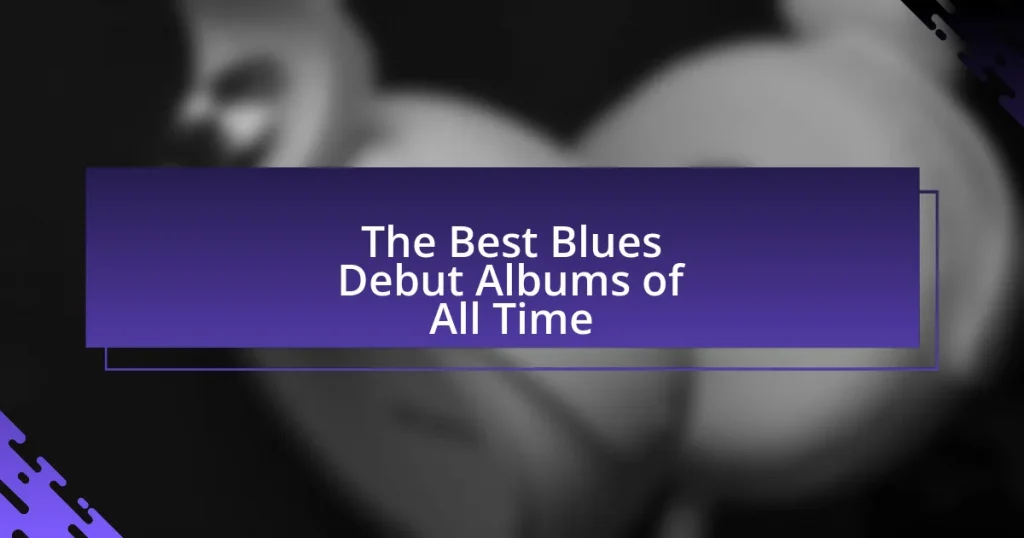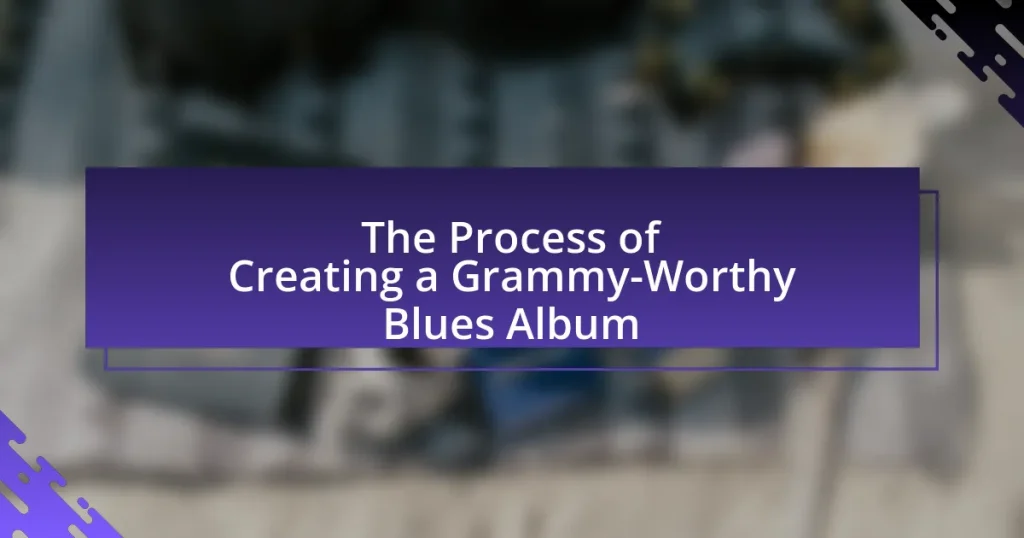The article focuses on the exploration of regional variations in Blues album styles, highlighting key characteristics such as instrumentation, lyrical themes, and stylistic elements across different regions. It examines how cultural history and historical events have shaped the sound of Blues music, with specific attention to Delta, Chicago, Texas, and West Coast Blues. The article also discusses the common instruments used in these styles, the impact of community and personal experiences on lyrical content, and how listeners can identify and appreciate the distinct features of each regional style. Overall, it provides a comprehensive overview of how regional influences contribute to the diversity and richness of the Blues genre.

What are the key characteristics of Blues music across different regions?
Blues music exhibits key characteristics that vary by region, including instrumentation, lyrical themes, and stylistic elements. In the Mississippi Delta, for example, the music often features acoustic guitars and harmonicas, with a focus on storytelling that reflects personal struggles and social issues. In contrast, Chicago blues incorporates electric guitars and a more urban sound, emphasizing a faster tempo and a full band setup, which reflects the city’s vibrant nightlife. Texas blues is characterized by a blend of country influences and a strong emphasis on guitar solos, showcasing a more upbeat and danceable style. Each regional variation maintains the fundamental twelve-bar structure and emotional depth typical of blues, but the specific sounds and themes adapt to local cultures and experiences.
How do regional influences shape the sound of Blues albums?
Regional influences significantly shape the sound of Blues albums by incorporating local musical traditions, cultural elements, and historical contexts. For instance, the Delta Blues, originating from the Mississippi Delta, features slide guitar techniques and a raw, emotional vocal style that reflects the hardships of the region’s African American communities. In contrast, Chicago Blues incorporates electric instruments and a more urban sound, influenced by the migration of Southern musicians to northern cities in the early 20th century. This migration led to the blending of rural and urban styles, resulting in a distinct sound characterized by amplified guitars and a strong rhythm section. Additionally, regional dialects and storytelling traditions in lyrics further enhance the authenticity and cultural resonance of Blues music, making it a reflection of the specific experiences and environments of its origins.
What specific instruments are commonly used in regional Blues styles?
Common instruments used in regional Blues styles include the guitar, harmonica, piano, and drums. The guitar, often played in both acoustic and electric forms, serves as the primary instrument in many Blues subgenres, such as Delta and Chicago Blues. The harmonica adds a distinctive sound, particularly in styles like Country Blues and Chicago Blues. The piano is frequently featured in Jump Blues and boogie-woogie styles, providing rhythmic and melodic support. Drums contribute to the overall rhythm and groove, essential in various Blues forms. These instruments collectively shape the unique sound of regional Blues styles, reflecting their cultural and historical contexts.
How do lyrical themes vary among different regional Blues styles?
Lyrical themes in regional Blues styles vary significantly, reflecting the cultural, social, and historical contexts of their origins. For instance, Delta Blues often emphasizes themes of hardship, love, and loss, rooted in the African American experience in the Mississippi Delta, as exemplified by artists like Robert Johnson. In contrast, Chicago Blues incorporates urban themes, focusing on city life, relationships, and resilience, as seen in the works of Muddy Waters. Texas Blues tends to blend storytelling with a more upbeat sound, often highlighting themes of pride and celebration, as demonstrated by artists like Stevie Ray Vaughan. These variations illustrate how regional influences shape the lyrical content, making each style distinct while still belonging to the broader Blues genre.
What role does cultural history play in shaping regional Blues styles?
Cultural history significantly influences regional Blues styles by embedding local traditions, social issues, and historical experiences into the music. For instance, the Delta Blues, originating from the Mississippi Delta, reflects the African American experience of slavery and poverty, incorporating elements of work songs and spirituals. In contrast, Chicago Blues evolved from the migration of Southern musicians to urban areas, integrating electric instruments and urban themes, which mirrored the industrialization and social changes of the 20th century. These regional adaptations demonstrate how cultural history shapes the sound, themes, and instrumentation of Blues, making it a reflection of the diverse experiences across different communities.
How have historical events influenced the development of Blues in specific regions?
Historical events have significantly influenced the development of Blues in specific regions by shaping the cultural and social contexts in which the music evolved. For instance, the Great Migration of African Americans from the rural South to urban centers in the North during the early to mid-20th century led to the emergence of Chicago Blues, characterized by electric instruments and a more urban sound. This migration was driven by the search for better economic opportunities and escape from Jim Crow laws, which directly impacted the musical styles that developed in these new environments. Additionally, the post-World War II era saw the rise of Rhythm and Blues, influenced by the socio-economic changes and the integration of African American culture into mainstream music, particularly in cities like New Orleans and Memphis, where local traditions blended with new influences. These historical contexts provide a framework for understanding how Blues music adapted and transformed in response to the changing social landscapes across different regions.
What cultural elements are integrated into regional Blues music?
Regional Blues music integrates various cultural elements, including African American spirituals, folk traditions, and local musical influences. These elements reflect the historical experiences and social contexts of the communities where Blues originated, such as the Mississippi Delta, Chicago, and Texas. For instance, the Delta Blues often incorporates call-and-response patterns derived from African musical traditions, while Chicago Blues features electric instruments and urban themes influenced by migration patterns. The blending of these cultural aspects creates distinct regional styles, showcasing the diversity within the genre.

What are the major regional styles of Blues music?
The major regional styles of Blues music include Delta Blues, Chicago Blues, Texas Blues, and West Coast Blues. Delta Blues originated in the Mississippi Delta and is characterized by its acoustic sound and emotional depth, often featuring slide guitar. Chicago Blues evolved from Delta Blues in the urban environment of Chicago, incorporating electric instruments and a more robust rhythm section, exemplified by artists like Muddy Waters. Texas Blues blends elements of Delta and Chicago styles, known for its use of guitar solos and a more upbeat tempo, with notable figures like Stevie Ray Vaughan. West Coast Blues emerged in California, characterized by a smoother, jazz-influenced sound, often featuring horns and a laid-back style, with artists like T-Bone Walker. Each style reflects the cultural and social influences of its region, contributing to the rich diversity of Blues music.
What defines Delta Blues and how does it differ from other styles?
Delta Blues is characterized by its raw, emotional expression, often featuring slide guitar techniques and a focus on personal storytelling. This style differs from other blues genres, such as Chicago Blues, which incorporates electric instruments and a more polished sound. Delta Blues typically employs acoustic guitars and simple, repetitive structures, reflecting the rural Southern origins of the genre, while other styles may utilize a full band and complex arrangements. The historical context of Delta Blues, emerging in the Mississippi Delta during the early 20th century, further distinguishes it from urban blues styles that developed later.
What are the signature features of Delta Blues albums?
Delta Blues albums are characterized by their raw, emotive sound, often featuring solo performances with acoustic guitar and harmonica. This style emphasizes personal storytelling, reflecting themes of hardship, love, and resilience. The use of slide guitar techniques and a distinctive rhythmic pattern, known as “bottleneck” playing, is prevalent, showcasing the musicians’ technical skill and emotional expression. Historically, artists like Robert Johnson and Muddy Waters exemplified these features, influencing the genre’s development and establishing a foundation for future blues styles.
How has Delta Blues influenced contemporary music?
Delta Blues has significantly influenced contemporary music by shaping genres such as rock, jazz, and hip-hop. The raw emotional expression and distinctive guitar techniques of Delta Blues artists, like Robert Johnson and Muddy Waters, laid the groundwork for the development of electric blues and rock and roll. For instance, the use of slide guitar and call-and-response patterns in Delta Blues can be traced in the works of modern musicians like Eric Clapton and The Rolling Stones, who have cited these early blues artists as major influences. Additionally, the lyrical themes of struggle and resilience found in Delta Blues resonate in contemporary hip-hop, where artists often draw on personal narratives and social commentary, reflecting the same spirit of storytelling.
What are the characteristics of Chicago Blues?
Chicago Blues is characterized by its electric instrumentation, a strong rhythm section, and a focus on expressive vocals. This style emerged in the 1940s, evolving from Delta Blues, and incorporates amplified guitars, harmonicas, and a prominent use of bass and drums. The genre often features a call-and-response pattern, reflecting its roots in African American musical traditions. Notable artists like Muddy Waters and Howlin’ Wolf exemplified these characteristics, contributing to the genre’s popularity and influence on rock music. The Chicago Blues sound is marked by its urban feel, contrasting with the acoustic and rural origins of earlier blues styles.
How does the instrumentation in Chicago Blues differ from other styles?
Chicago Blues primarily features electric instruments, distinguishing it from other blues styles that often rely on acoustic instrumentation. The use of electric guitars, amplified harmonicas, and a rhythm section that includes bass and drums creates a more powerful and urban sound. This instrumentation evolved in the 1940s and 1950s, influenced by the migration of African Americans to Chicago, where artists like Muddy Waters and Howlin’ Wolf popularized the electric sound. In contrast, Delta Blues typically emphasizes acoustic guitars and slide techniques, while Texas Blues incorporates a mix of electric and acoustic elements but often retains a more laid-back feel. The electric instrumentation in Chicago Blues allows for greater volume and a more pronounced rhythmic drive, setting it apart from these other regional styles.
What impact did urbanization have on the Chicago Blues sound?
Urbanization significantly transformed the Chicago Blues sound by introducing electric instruments and amplifying the music’s emotional intensity. As African Americans migrated to Chicago during the Great Migration, they brought rural blues traditions with them, which evolved in urban settings. The availability of clubs and venues in Chicago facilitated the blending of various musical influences, leading to a more robust and dynamic sound characterized by the use of electric guitars, harmonicas, and a strong rhythm section. This shift was evident in the works of artists like Muddy Waters and Howlin’ Wolf, who adapted their styles to the urban environment, creating a distinct Chicago Blues sound that became influential in the broader blues genre.
What makes Texas Blues unique?
Texas Blues is unique due to its distinctive blend of traditional Delta blues and the influence of Texas country music, characterized by a strong emphasis on guitar work and a more upbeat tempo. This genre often features the use of electric guitars, which became prominent in the 1940s and 1950s, allowing for a more expressive sound. Notable artists like Stevie Ray Vaughan and Freddie King exemplify this style, showcasing intricate guitar solos and a powerful vocal delivery. The incorporation of swing rhythms and a focus on improvisation further differentiate Texas Blues from other regional styles, making it a vibrant and dynamic form of blues music.
How do Texas Blues artists incorporate elements from other genres?
Texas Blues artists incorporate elements from other genres by blending traditional blues with influences from country, rock, jazz, and even Tejano music. This fusion is evident in the use of varied instrumentation, such as the incorporation of steel guitars and fiddles, which are common in country music, alongside the standard blues guitar and harmonica. Additionally, Texas Blues often features a more rhythmic and upbeat style, drawing from rock and roll, which can be seen in the works of artists like Stevie Ray Vaughan, who combined blues with rock elements to create a distinctive sound. The integration of jazz improvisation techniques is also prevalent, allowing for more expressive solos and complex arrangements, as demonstrated by artists like Johnny Winter. This cross-genre experimentation enriches the Texas Blues sound, making it unique within the broader blues genre.
What are the notable Texas Blues albums and their significance?
Notable Texas Blues albums include “Texas Flood” by Stevie Ray Vaughan, “Live at Antone’s” by Jimmie Vaughan, and “The Sky Is Crying” by Stevie Ray Vaughan and Double Trouble. “Texas Flood,” released in 1983, is significant for revitalizing the blues genre in the 1980s and showcasing Vaughan’s exceptional guitar skills and emotional depth. “Live at Antone’s,” recorded in 1990, highlights Jimmie Vaughan’s influence on the Texas Blues scene and his ability to blend traditional blues with contemporary elements. “The Sky Is Crying,” released posthumously in 1991, features previously unreleased tracks and emphasizes Vaughan’s mastery of the blues, solidifying his legacy as one of the genre’s greatest guitarists. These albums collectively represent the rich heritage and evolution of Texas Blues, influencing countless musicians and shaping the sound of modern blues.

How do Blues album styles reflect regional identity?
Blues album styles reflect regional identity through distinct musical characteristics, instrumentation, and lyrical themes that are influenced by the cultural and historical context of specific areas. For example, Delta blues, originating from the Mississippi Delta, features acoustic guitar and harmonica, emphasizing raw emotion and storytelling, which mirrors the struggles of rural life in that region. In contrast, Chicago blues incorporates electric instruments and a more urban sound, reflecting the migration of African Americans to cities and the influence of jazz and rock. This regional diversity is further evidenced by the unique lyrical content that often addresses local issues, such as economic hardship or social justice, thereby reinforcing the connection between the music and the identity of the community it represents.
What are the common themes found in regional Blues albums?
Common themes found in regional Blues albums include personal struggles, love and heartbreak, social issues, and cultural identity. Personal struggles often reflect the artist’s life experiences, such as poverty and hardship, which are prevalent in Delta Blues. Love and heartbreak are central to many songs, expressing deep emotional connections and losses, particularly in Chicago Blues. Social issues, including racism and inequality, are frequently addressed, especially in the context of urban Blues scenes. Cultural identity is also a recurring theme, showcasing the unique influences of different regions, such as the Southern roots in Memphis Blues or the urban influences in Detroit Blues. These themes are consistently represented across various regional styles, illustrating the genre’s rich narrative tradition.
How do personal experiences of artists shape their regional Blues albums?
Personal experiences of artists significantly shape their regional Blues albums by influencing the themes, lyrics, and musical styles they incorporate. For instance, artists often draw from their life stories, cultural backgrounds, and local environments, which reflect the unique social and historical contexts of their regions. This is evident in the Delta Blues, where artists like Robert Johnson infused their narratives of hardship and resilience, rooted in the African American experience in the Mississippi Delta. Similarly, Chicago Blues artists, such as Muddy Waters, incorporated urban experiences and electric instrumentation, showcasing the transition from rural to urban life. These personal narratives not only resonate with listeners but also preserve and communicate the cultural heritage of the regions, making the albums authentic representations of their origins.
What role does community play in the creation of regional Blues music?
Community plays a crucial role in the creation of regional Blues music by providing a cultural and social framework that influences musical expression. The shared experiences, histories, and struggles of community members shape the themes and styles found in Blues music, reflecting local traditions and narratives. For instance, the Mississippi Delta Blues is deeply rooted in the African American community’s experiences, with artists like Robert Johnson drawing from local folklore and social issues. This connection to community not only informs the lyrical content but also affects the musical techniques and instrumentation used, as seen in the distinct sounds of Chicago Blues compared to Texas Blues, which are both shaped by their respective communities.
How can listeners identify regional variations in Blues albums?
Listeners can identify regional variations in Blues albums by analyzing the musical elements, lyrical themes, and instrumentation that reflect specific geographic influences. For instance, Delta Blues, originating from the Mississippi Delta, often features acoustic guitars and harmonicas, while Chicago Blues incorporates electric guitars and a more urban sound. Additionally, lyrical content may vary, with Southern styles focusing on rural life and hardships, while Northern styles might address urban experiences. Historical context also plays a role; the Great Migration influenced the transition of Blues from the South to urban centers, leading to distinct regional characteristics.
What are the key indicators of a specific regional style in a Blues album?
Key indicators of a specific regional style in a Blues album include instrumentation, lyrical themes, vocal techniques, and rhythmic patterns. For example, Delta Blues often features acoustic guitars and harmonicas, while Chicago Blues typically incorporates electric guitars and a full band setup. Lyrically, Southern styles may focus on personal hardship and rural life, whereas urban styles might address social issues and nightlife. Vocal delivery also varies; for instance, the emotive, raw style of Delta Blues contrasts with the more polished, powerful singing found in Memphis or Chicago Blues. Additionally, rhythmic patterns can differ, with some regions favoring shuffle rhythms while others may lean towards straight beats, reflecting local musical influences.
How can understanding regional styles enhance the listening experience?
Understanding regional styles enhances the listening experience by providing context and depth to the music, allowing listeners to appreciate the cultural influences and historical backgrounds that shape each style. For example, the Delta blues, originating from the Mississippi Delta, is characterized by its raw emotional expression and acoustic instrumentation, reflecting the hardships of the region’s history. In contrast, Chicago blues incorporates electric instruments and a more urban sound, showcasing the evolution of the genre as it adapted to city life. By recognizing these distinctions, listeners can connect more deeply with the music, gaining insights into the artists’ experiences and the societal factors that influenced their work. This enriched understanding fosters a more immersive and meaningful engagement with the music.
What are some best practices for exploring regional Blues album styles?
To effectively explore regional Blues album styles, one should prioritize listening to a diverse range of artists from specific regions, as this exposes the unique characteristics and influences of each style. For instance, Delta Blues, originating from Mississippi, is characterized by its acoustic sound and emotional storytelling, while Chicago Blues incorporates electric instruments and a more urban feel. Engaging with local music scenes through live performances and festivals can also provide deeper insights into the cultural context and evolution of these styles. Additionally, studying the historical background of each region’s music scene, including key figures and landmark recordings, enhances understanding. For example, the significance of Muddy Waters in Chicago Blues illustrates how individual artists can shape regional sounds.



